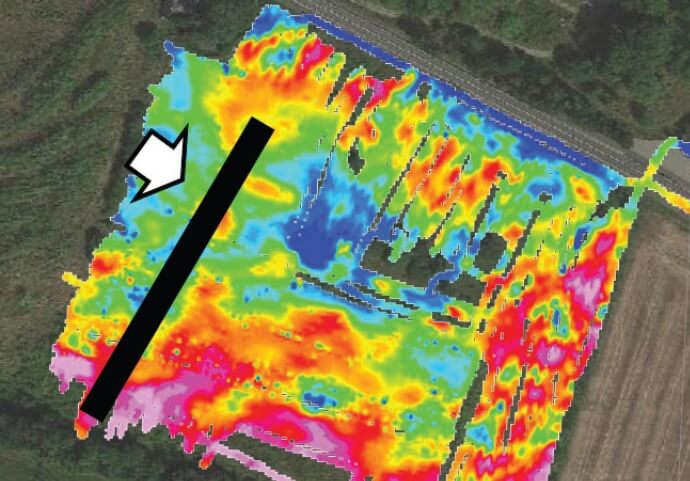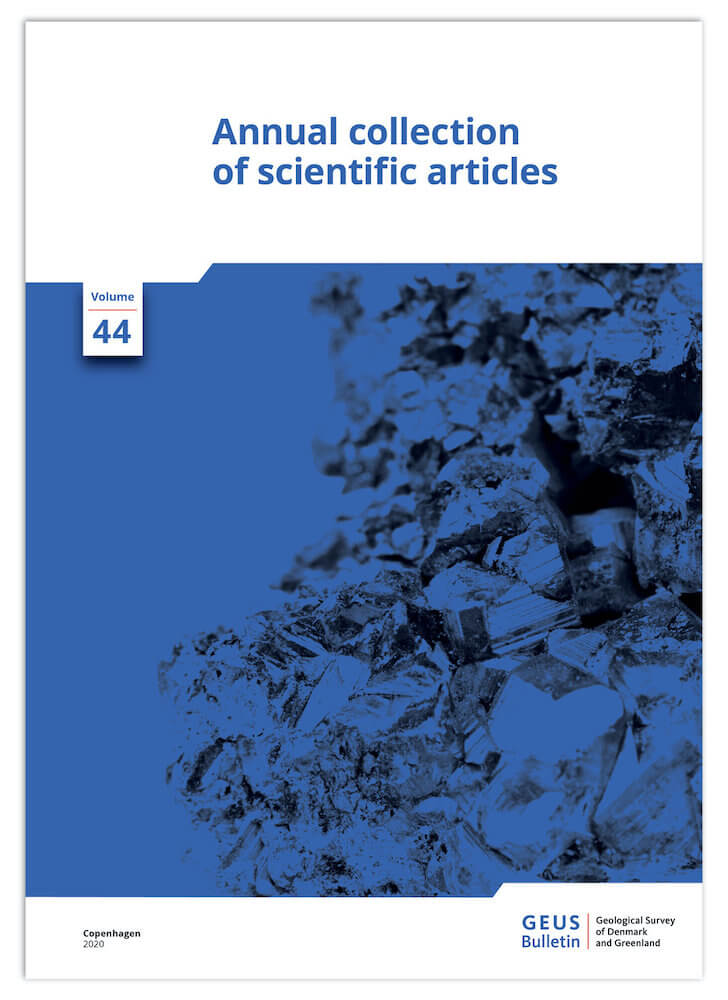
How to Cite
Share
Abstract
Geophysical methods have been widely used in recent decades to investigate and monitor landfill sites for environmental purposes. With the advent of the circular economy, waste contained in old landfills may be considered a resource that can be developed. Since the content of old landfills is largely unknown, the occurrence and quantity of valuable materials must be investigated before embarking on any development activity. Two landfills on Sjælland, Denmark (located at Hvalsø and Avedøre) were selected for a pilot study to characterise their content. At both locations, a set of geophysical surveys is underway. Here, we present the data obtained from magnetic and 2D seismic refraction surveys. Magnetic data show various anomalies that can be interpreted as caused by iron-rich waste. At both sites, the landfill material results in generally low P-wave velocity (<400 m/s), lower than those obtained for Quaternary sediments at Avedøre. The seismic velocities appear to increase in the presence of metals or by compaction with depth (>550 m/s). We propose that seismic refraction can thus define the bottom of the landfill and possibly its internal structure, especially when combined with other methods.
How to Cite
Share
Copyright (c) 2020 Alessandro Sandrin, Aleksandar Maricak, Björn H. Heincke, Rune J. Clausen, Lars Nielsen, Jakob K. Keiding

This work is licensed under a Creative Commons Attribution 4.0 International License.
Downloads
References
-
Balia, R. & Littarru, B. 2010: Geophysical experiments for the pre-reclamation assessment of industrial and municipal waste landfills. Journal Geophysical Engineering 7, 64–74. https://doi.org/10.1088/1742-2132/7/1/006
-
Belghazal, H. et al. 2013: Geophysical surveys for the characterization of landfills. International Journal of Innovation and Applied Sciences 4, 254–263.
-
Biorem. 2016: National network of test sites. https://www.danishsoil.org/testsites/projekt.php?id=173 (accessed 2019)
-
Blumenthal, K. 2011: Generation and treatment of municipal waste. Eurostat (European Commission), Luxembourg. KS-SF-11-031-EN-C. https://op.europa.eu/s/n3Qi
-
Boudreault, J.P. et al. 2010: Geophysical characterization of contaminated urban fills. Engineering Geology 116, 196–206. https://doi.org/10.1016/j.enggeo.2010.09.002
-
Cardarelli, E. & Di Filippo, G. 2004: Integrated geophysical surveys on waste dumps: evaluation of physical parameters to characterize an urban waste dump (four case studies in Italy). Waste Management Research 22, 390–402. https://doi.org/10.1177/0734242x04046042
-
Carpenter, P.J., Reddy, K.R. & Thompson, M.D. 2013: Seismic imaging of a leachate-recirculation landfill: spatial changes in dynamic properties of municipal solid waste. Journal of Hazardous, Toxic, and Radioactive Waste 17, 331–341. https://doi.org/10.1061/(asce)hz.2153-5515.0000175
-
De Iaco, R. et al. 2003: A combined seismic reflection and refraction study of a landfill and its host sediments. Journal of Applied Geophysics 52, 139–156. https://doi.org/10.1016/s0926-9851(02)00255-0
-
Di Maio, R. et al. 2018: 3D geophysical imaging for site-specific characterization plan of an old landfill. Waste Management 76, 629–642. https://doi.org/10.1016/j.wasman.2018.03.004
-
Dumont, G. et al. 2017: Assessment of multiple geophysical techniques for the characterization of municipal waste deposit sites. Journal Applied Geophysics 145, 74–83. https://doi.org/10.1016/j.jappgeo.2017.07.013
-
Frändegård, P., Krook, J. & Svensson, N. 2015: Integrating remediation and resource recovery: on the economic conditions of landfill mining. Waste Management 42, 137–147. https://doi.org/10.1016/j.wasman.2015.04.008
-
GEUS Borerapport DGU 208. 3888. 1999: In Danish. Available upon request: https://www.geus.dk/produkter-ydelser-og-faciliteter/data-og-kort/national-boringsdatabase-jupiter/
-
Green, A. et al. 1999: A template for geophysical investigations of small landfills. The Leading Edge 18, 248–254. https://doi.org/10.1190/1.1438264
-
Jackson, T. 2009: Prosperity without growth. Economics for a finite planet. 288 pp. London: Routledge. https://doi.org/10.4324/9781849774338
-
Jones, P.T. et al. 2013: Enhanced landfill mining in view of multiple resource recovery: a critical review. Journal of Cleaner Production 55, 45–55. https://doi.org/10.1016/j.jclepro.2012.05.021
-
Kieckhäfer, K., Breitenstein, A. & Spengler, T.S. 2017: Material flow-based economic assessment of landfill mining processes. Waste Management 60, 748–764. https://doi.org/10.1016/j.wasman.2016.06.012
-
Konstantaki, L.A. et al. 2016: Wet and gassy zones in a municipal landfill from P- and S-wave velocity fields. Geophysics 81, 75–86. https://doi.org/10.1190/geo2015-0581.1
-
Krook, J., Svensson, N. & Eklund, M. 2012: Landfill mining: a critical review of two decades of research. Waste Management 32, 513–520. https://doi.org/10.1016/j.wasman.2011.10.015
-
Laner, D. et al. 2019: Systematic assessment of critical factors for the economic performance of landfill mining in Europe: what drives the economy of landfill mining? Waste Management 95, 674–686. https://doi.org/10.1016/j.wasman.2019.07.007
-
Lanz, E., Maurer, H. & Green, A. G. 1998: Refraction tomography over a buried waste disposal site. Geophysics 63, 1414–1433. https://doi.org/10.1190/1.1444443
-
Marchetti, M., Sapia, V. & Settimi, A. 2013: Magnetic anomalies of steel drums: a review of the literature and research results of the IGNV. Annals of Geophysics 56, R0108. https://doi.org/10.4401/ag-6201
-
Nielsen, L. Boldreel, L.O., Hansen, T.M., Lykke-Andersen, H., Stemmerik, L., Surlyk, F. & Thybo, Het al. 2011: Integrated seismic analysis of the Chalk Group in eastern Denmark — implications for estimates of maximum palaeo-burial in southwest Scandinavia. Tectonophysics 511, 14–26. https://doi.org/10.1016/j.tecto.2011.08.010
-
Nourani, M.H., Moghadder, M.T. & Safari, M. 2017: Classification and assessment of rock mass parameters in Choghart iron mine using P-wave velocity. Journal of Rock Mechanics and Geotechnical Engineering 9, 318–328. https://doi.org/10.1016/j.jrmge.2016.11.006
-
Puthussery, J.V., Kumar, R. & Garg, A. 2017: Evaluation of recycled concrete aggregates for their suitability in construction activities: an experimental study. Waste Management 60, 270–276. https://doi.org/10.1016/j.wasman.2016.06.008
-
Reichmann, H.J. & Jacobsen, S.D. 2004: High-pressure elasticity of a natural magnetite crystal. American Mineralogist 89, 1061–1066. https://doi.org/10.2138/am-2004-0718
-
Roskilde Amt Teknisk Forvaltning 2003: Rapport Historisk redegørelse – fyldpladser. Lokalitet nr. 257.001, metr. nr. 4al, 8g og 8h, Kirke Hvalsø By, Kirke Hvalsø, Hvalsø Kommune. 16 pp. In Danish. https://www.danishsoil.org/media/test_sites/7/documents/Historisk%20redeg%C3%B8relse2.pdf (accessed 2019)
-
Rune J. Clausen, R.J. & Kalvig, P. MiMa rapport 2020/2. Muligheder og udfordringer for landfill mining i Danmark. ISBN 978-87-7871-536-4. http://mima.geus.dk/udgivelser/landfill-mining-2020/
-
Salisbury, M.H., Milkereit, B. & Bleeker, W: 1996: Seismic imaging of massive sulfide deposits; Part I, Rock properties. Economic Geology 91, 821–828. https://doi.org/10.2113/gsecongeo.91.5.821
-
Sandmeier, K.J. 2014: ReflexW - Version 9.0 (User guide), pp. 341. Sandmeier Geophysical Research, Karlsruhe, Germany. https://www.sandmeier-geo.de/Download/reflexw_manual_a4.pdf (accessed 2019)
-
Savage, G.M., Golueke, C.G. & von Stein, E.L. 1993: Landfill mining: past and present. Biocycle 34, 58–61.
-
Wagner, T.P. & Raymond, T. 2015: Landfill mining: case study of a successful metals recovery project. Waste Management 45, 448–457. https://doi.org/10.1016/j.wasman.2015.06.034
-
WWF. 2014: Living Planet Report 2014: species and spaces, people and places. World Wide Fund for Nature (WWF), Switzerland. https://www.worldwildlife.org/pages/living-planet-report-2014 (accessed 2019)









